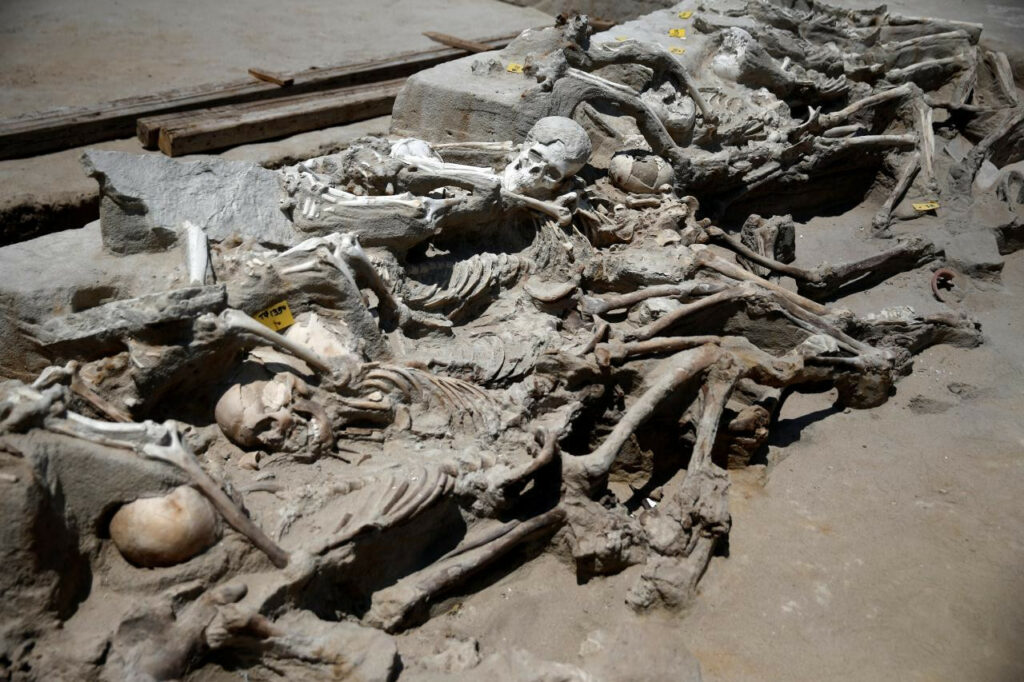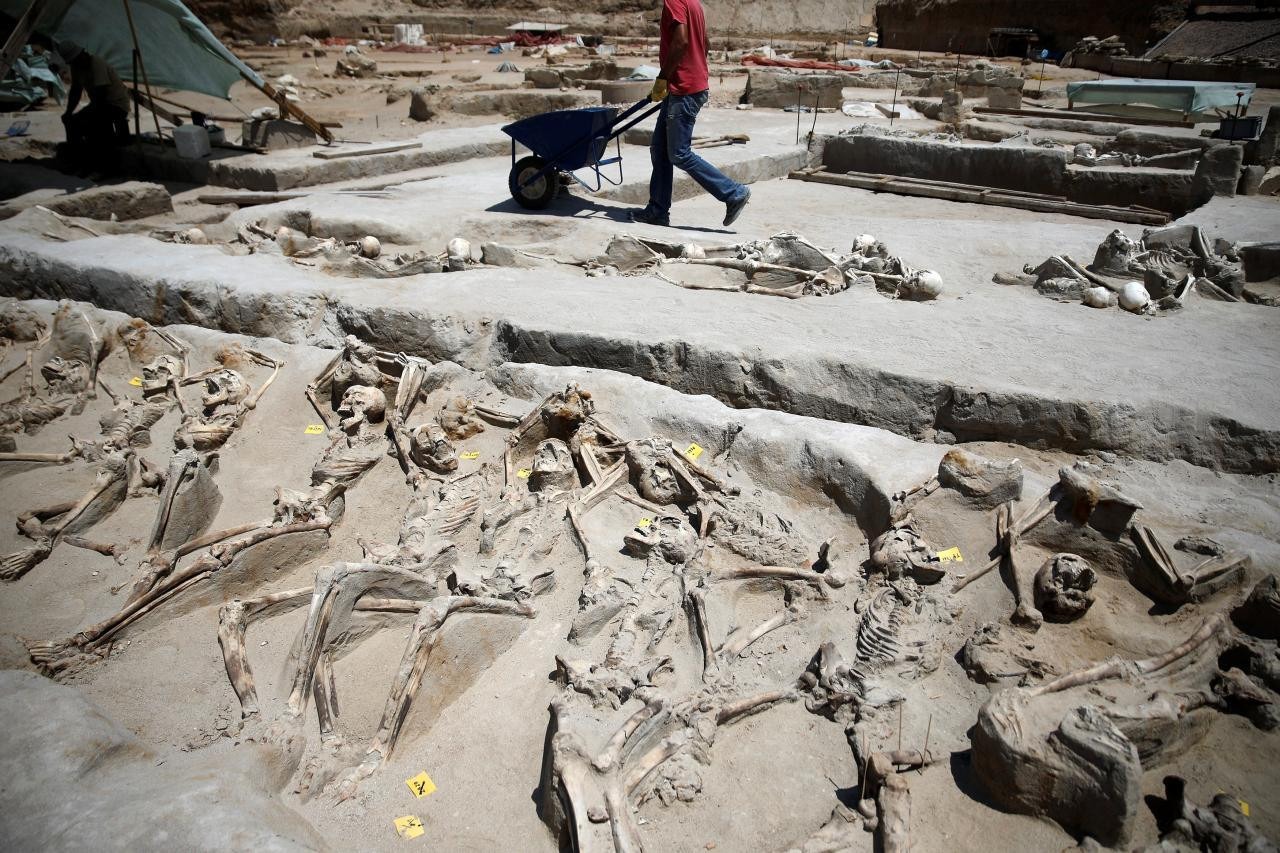Beneath the vibrant streets of modern Athens, where ancient ruins coexist with glass towers and bustling cafés, a chilling discovery has emerged — a mass grave containing 80 shackled skeletons, each a silent witness to one of the most violent chapters in Greece’s early history.
A Chilling Discovery Beneath Athens

The find was made during construction work near the Faliron Delta, a coastal area just southwest of central Athens. The site, once a bustling port in antiquity, has long served as a necropolis — but nothing prepared archaeologists for the grim scene they encountered.
Beneath layers of sandy soil, eighty human skeletons lay in neat rows, their wrists still bound in iron shackles. Many were found with their arms raised or crossed tightly against their bodies, as if frozen in their final moments. The precision of their arrangement, however, hinted at a deliberate and organized burial rather than hasty disposal.
“This is not a chaotic burial,” said Dr. Stella Chryssoulaki, head of the excavation. “They were placed carefully, even respectfully, though clearly victims of violence. That paradox tells us something profound about Athenian society — its brutality, but also its order.”
The Clues Hidden in the Bones

Preliminary osteological analysis revealed that most of the victims were young men, physically fit, and likely in their twenties or thirties. Their wrists bore heavy iron manacles — stark evidence of imprisonment or execution. Yet, no signs of random violence or mass panic were found at the site, suggesting a single, orchestrated event.
The burial is thought to date to the 7th century BCE, a turbulent era in Athenian history marked by political upheaval, class conflict, and power struggles among the city’s aristocrats. Pottery shards and grave context align with this period, placing the deaths roughly around 632 BCE.
The Cylon Hypothesis
The leading theory among historians connects the Faliron skeletons to the failed coup of Cylon, an Athenian noble and Olympic champion who attempted to seize power and install himself as tyrant.
According to ancient accounts, Cylon — inspired by the rise of autocrats in other Greek city-states — gathered supporters and took control of the Acropolis. But his plan collapsed after an armed standoff. Cylon managed to escape, but his followers surrendered under a promise of mercy. Instead, they were executed — bound and slain near the coast, according to historians like Thucydides and Herodotus.
The discovery of the shackled skeletons at Faliron, near the sea, fits this narrative almost eerily well. “It’s the first tangible archaeological evidence that may correspond to that episode,” said Dr. Chryssoulaki. “These could be the very men whose deaths sparked one of the defining moments in Athenian justice and governance.”
A Window into Early Athenian Society

The Faliron Delta necropolis is not a typical cemetery for elites. Excavations have uncovered more than 1,500 burials, ranging from infants buried in ceramic jars to adults in stone coffins and shallow graves. The site provides an unprecedented glimpse into the social diversity of ancient Athens, spanning from the 8th to the 5th centuries BCE.
Unlike the grand tombs of the Kerameikos cemetery, Faliron’s burials represent the broader population — merchants, sailors, soldiers, and possibly prisoners. The mass grave of shackled men, however, stands out for its political undertone.
“These were not slaves,” emphasized Dr. Chryssoulaki. “Their condition and burial treatment indicate they were citizens — likely men caught on the wrong side of a political conflict.”
The Science Behind the Story
To unravel the truth, researchers are employing cutting-edge forensic techniques. DNA sequencing and isotopic analysis aim to determine whether the victims were local Athenians or outsiders, while micro-examination of the bones may reveal signs of trauma, execution methods, or even diseases.
The study of iron residues on the shackles could also identify the forging methods used, helping archaeologists confirm the period with greater precision. Advanced 3D mapping of the site ensures every skeleton is digitally preserved before conservation begins.
“This is a forensic investigation on an archaeological scale,” explained Dr. Nikolaos Papadopoulos, one of the researchers. “Every chain, every position, every bone tells part of a story — a story of power, betrayal, and the birth of democracy.”
Between Tragedy and Transformation
The Faliron discovery is more than an ancient crime scene — it’s a reflection of Athens in transition, from a society ruled by noble families to one inching toward the ideals of law and citizen rights. The public outrage following Cylon’s coup and the massacre of his followers set in motion a series of reforms that ultimately laid the groundwork for Athenian democracy.
In that sense, the shackled skeletons may mark not only a moment of horror but also a turning point in human governance — where the struggle against tyranny became a cornerstone of political identity.
Preserving the Past
Plans are underway to preserve the site as an open-air archaeological museum, allowing visitors to witness this haunting yet historically pivotal discovery. Researchers envision an educational space where ancient tragedy meets modern reflection — a reminder that freedom and justice often emerge from the darkest moments of history.
In the words of Dr. Chryssoulaki:
“A cemetery is a photograph of those who passed — their lives, their deaths, their world. The Faliron Delta tells us not just how Athenians died, but how Athens itself was born.”
